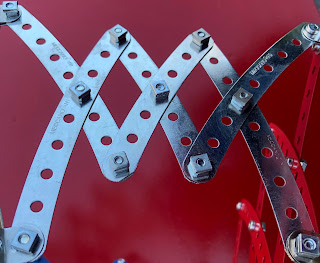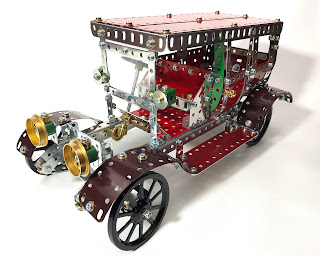Recently I picked this up in a charity shop for a few dollars:


A very nice
Hoberman sphere - or something like it, since the original Hoberman sphere was apparently an
icosidodecahedron, whereas this one has 24 identical kite-shaped faces that meet at 18 4-way junctions and 8 3-way junctions. If you know what such a thing is called, let me know.
The entire thing is made of just 6 types of part: the 4-way junction cap, the links that meet there (male and female versions), and similarly for the 3-way case, in which the links are slightly shorter.
When I got home I could hardly fail to start tinkering with Meccano and see what might be possible. I did not find any prior art on Meccano Hoberman spheres (although I have found plenty since; after 100+ years there is little new under the Meccano sun). I started with a basic expanding linkage:



Note that for the whole circle to collapse satisfactorily, the strips must be joined at points that are offset slightly from their center, here achieved using fish plates. The next step was to use curved strips to achieve the same thing:


This was a very pleasing model in itself, fun to fiddle with, but I could not stop there so I made the obvious 3D version. It came together easily enough, given the patience to attach 96 bolts and 96 nyloc nuts.


I found this one quite photogenic, so here are some more pictures:






In retrospect, this would have been a perfect time to stop, but I did not. This model expands, but only by about 20% - nothing like the original, which also has far more vertices. I
had to go on!
To make a very long story shorter, I ended up with this:




It is 16" in diameter when closed and 35" when open. It uses 288 curved strips part 89, which I had just enough of, thanks to the 2003 Ferris Wheel sets that keep turning up in said charity shop (hence the unfortunate colors; all zinc would be nicer). It also uses 528 bolts and 1056 nuts, all lock-nutted in pairs (I did not have enough nyloc nuts for the job). It took dozens of hours to make, of which 10% were fun design and tinkering and 90% were entirely menial. I have never lock-nutted so much in my life, and I never will again.
So I honestly cannot recommend this as a Meccano project for any sane human being. It was mind-numbingly repetitive and fiddly. If however you still want to give it a shot, read on and perhaps you can benefit from my research and mistakes.
Detailed construction notes
What polyhedron is my plastic toy based on? I did not find it described online. Though the faces all have the same trapezoidal (kite) shape, there are two types of vertex, one where 4 edges meet and one where 3 do, and two types of edge, as the ones that meet at 3-way junctions are necessarily shorter than the ones that meet at 4-way junctions.
The vertices are not hard to model, except that the 3-way ones need angle brackets opened out to an angle of 120°. Here is a close-up of both types of vertex:


The two types of edge are a little harder. For the longer type, I used three "scissors" made from pairs of 11-hole curved strips lock-nutted at their central hole:


But the shorter edges need to be shorter by a very exact ratio, which I just about managed to calculate using
spherical trigonometry as 0.78365. Not easy to achieve in Meccano. I found an ugly way to make an edge that is 0.73333 smaller by chopping down some of the curved strips like this:

This 7% inaccuracy is a hidden advantage. The perfect ratio would allow the sphere to expand fully, making it extremely hard to collapse again without 3 people manipulating it at once. This inexact ratio constrains the sphere to a maximum size that collapses again without effort.
Nothing else about the construction was especially interesting. The main remaining question, as always, is what to do now with this big unwieldy hunk of metal. Somehow I don't think my children will want it in their inheritance...
There is a ton of fascinating further reading about 3D expanding structures online. I will link to just one:
3-dimensional Expanding Structures (pdf). These MIT lecture notes cover a lot of the subtleties in a way I have not seen elsewhere.







































